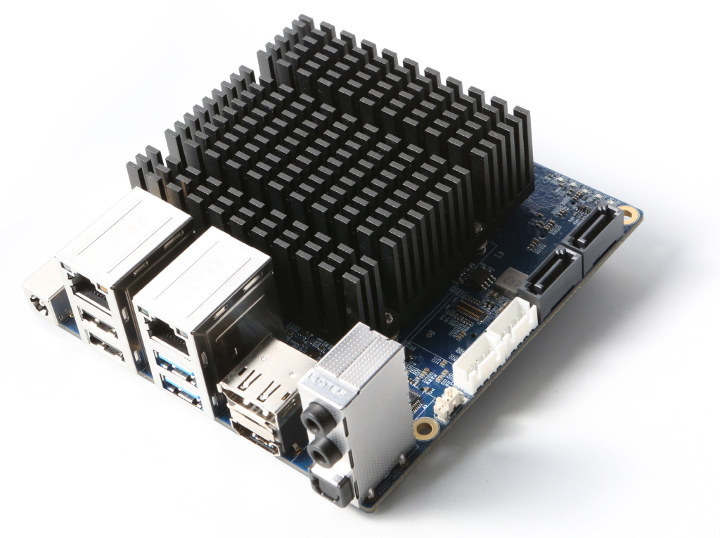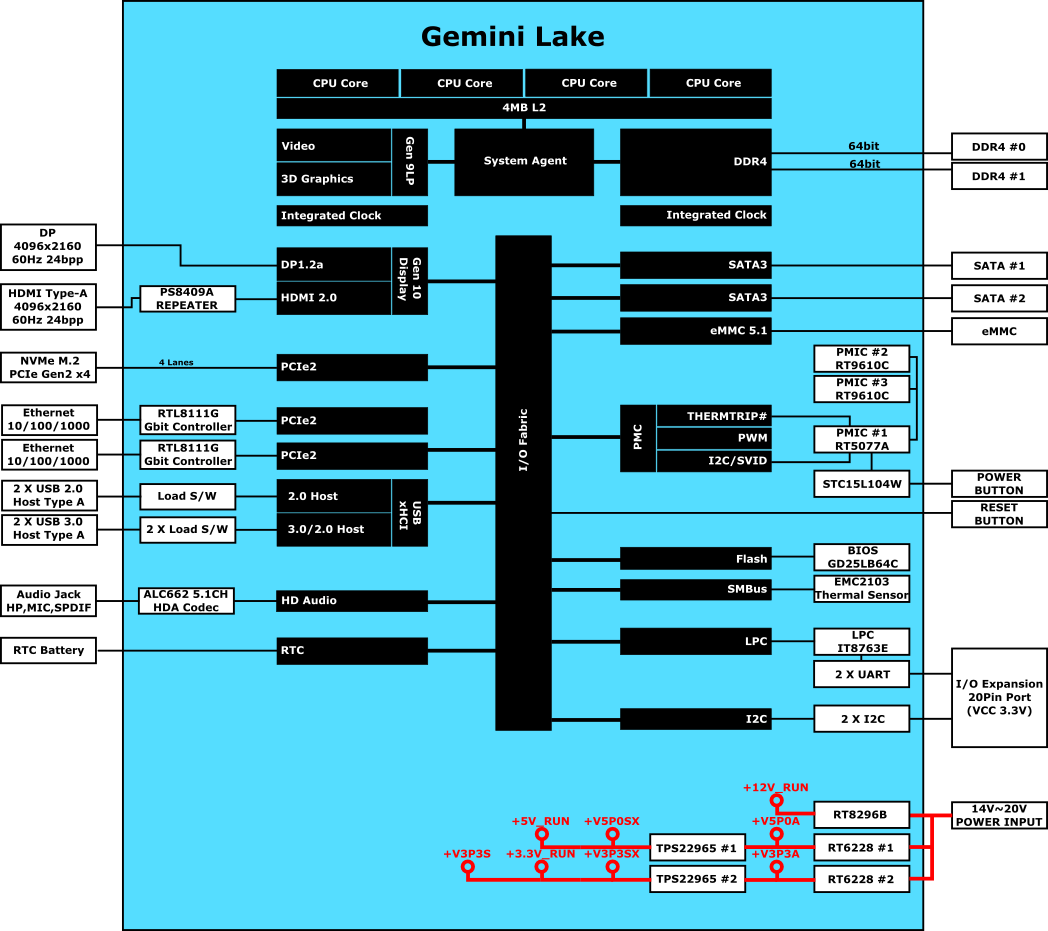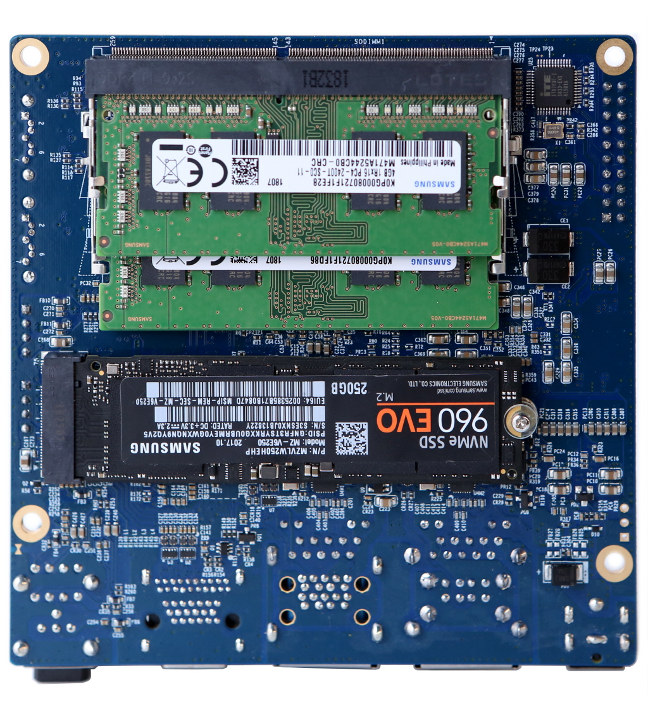There were talks about Hardkernel working on an ODROID x86 board since last year, as the CEO expected to launch such board later in 2017 in an interview published in ODROID magazine. Finally, it took them several iterations and processors considerations before being ready for launch, and ODROID-H2 should become available next month as the first ODROID x86 board.
ODROID-H2 will feature an Intel Celeron J4105 Gemini Lake processor, two SO-DIMM slots for memory, two SATA ports and M.2 NVMe slot for storage, two Gigabit Ethernet ports, a mix of USB 3.0 and 2.0 ports, and more.
 ODROID-H2 board specifications:
ODROID-H2 board specifications:
- SoC – Intel Celeron J4105 quad core processor @ up to 2.3 GHz (real frequency) with 12EU Intel UHD Graphics 600
- System Memory – Dual-channel Memory DDR4-PC19200 (2400MT/s) supporting up to 32GiB RAM in total
- Storage – M.2 PCIe 2.0 x4 slot for one NVMe storage, 2x SATA 3.0 ports, eMMC flash support
- Video Output
- HDMI 2.0 up to 4K (4096×2160) @ 60 Hz
- DisplayPort 1.2 up to 4K (4096×2160) @ 60 Hz
- Audio – HDMI, audio jacks for HP, MIC. and S/PDIF
- Connectivity – Dual Gigabit Ethernet (RJ45)
- Expansion – 20-pin header with I2C and UART (3.3V)
- Misc – RTC battery
- Power Supply – 14V to 20V DC power input
- Dimensions – 110x110x43mm
- Weight – About 320 grams with heatsink, two DRAM modules, and M.2 NVMe SSD.

ODROID-H2 is in the final stage of development and become available in November, with shipment expected later that month. The company did various performance, thermal design and power consumption testing on the board with Ubuntu 18.04 as documented in the forum post linked in the introduction. Basically the board can stay cool (under 70°C) under heavy load, consumes 4 watts at idle, and up to 22 Watts during a CPU+GPU stress test, and 4K 60fps H.265 to 720p H.264 video transcoding can be done faster than real-time with performance improving by 25% when using dual channel RAM configuration.

The company also posted a video showing the board run Ubuntu 18.10 with Kernel 4.18 from eMMC storage. They ran Dolphin emulator accelerated by Vulkan GPU driver and could play Wii games with three players smoothly.
What we do not know is the price, but since Hardkernel ODROID-H2 had a competitor with LattePanda Delta board we can get an idea. The LattePanda board comes with a similar Celeron N4100 processor, but contrary to the Hardkernel board it also includes RAM and storage soldered on the board. The board is not available anymore, but LattePanda Delta 432 model which included 4GB RAM and 32GB eMMC flash was offered for $139 on Kickstarter [Note; A previous version of this post incorrectly use LattePanda Alpha as reference]. Based one this information, and typical price for Celeron J4105 mini PCs, I’d expect the barebone version of ODROID-H2 board to sell for around $120-$140 without accessories considering it also includes extra features like dual Ethernet, dual SATA, NVMe SSD support, etc.. often not found in lower cost mini PCs.

Jean-Luc started CNX Software in 2010 as a part-time endeavor, before quitting his job as a software engineering manager, and starting to write daily news, and reviews full time later in 2011.
Support CNX Software! Donate via cryptocurrencies, become a Patron on Patreon, or purchase goods on Amazon or Aliexpress






I was impatiently waiting for their board announcement hoping for a nice powerful ARM SoC. And we get this, another x86 PC. This will have many uses (even Windows) but that’s so uninspiring to me 🙂
I’ll have to wait more to get a nice ARM board with good Linux support (beyond my TX2).
at the end of odroid forum post (2nd link in cnx article), it is stated that odroid N2 is coming “soon”
I completely missed that and thought that N2 had been dropped in favor of H2! Thanks a lot for pointing me to the thread 🙂
(I’m slightly disappointed it’s only A73 but I’m still interested.)
Ahem, ‘real frequency’ as in ‘turbo boost, subject to thermal constraints, number of cores active, etc’:
https://ark.intel.com/products/128989/Intel-Celeron-J4105-Processor-4M-Cache-up-to-2-50-GHz-
as far as i know, the max turbo boost freq from intel webpage is the one you can reach in single thread load only
multi thread loads often have a lower max frequency…
Nobe is right, that processor has a turbo boost of 2.5 Ghz, but all four cores can sustain 2.3 GHz provided proper cooling which Hardkernel tested with stress-ng (There’s also a chart in the forum, second link in this post).
Unfortunately testing with ‘stress-ng –cpu-method all’ is not the best thermal stress test. A matrix multiplier would be a better stress test.
From http://kernel.ubuntu.com/~cking/stress-ng:
‘maxtrixprod — matrix product of two 128 * 128 matrices of double floats. Testing on 64 bit x86 hardware shows that this is provides a good mix of memory, cache and floating point operations and is probably the best CPU method to use to make a CPU run hot.’
Why is this enclosure-less Mini PC called a ‘Development Board’?
Who called it a development board?
I did. I changed the title to “Single Board Computer” shortly after, since it better reflects the product’s capabilities.
But is it an SBC? SInce it does not have ram embedded onto the board. But TBH I also prefer SBC instead of mini motherboard
I applaud this move from Hardkernel. Let’s face it, Arm SOCs always needed to have the Linux kernel ported to them, and by the time the kernel was mainlined; if it ever became mainlined, a newer SOC was released by the same manufacturer and the current SOC became obsolete.
For this reason alone, going x86 makes so much sense especially above the $120 price tag. Also the ability to install any distro with its default x86-64 iso file available on the distro site is just fantastic.
Arm is still great at for cheaper boards in the less than $60 range.
is this good for a pfsense gateway where I could pack kodi and freenas into a VM to have a 3-in-1 (firewall, mediaplayer, NAS) with low power footprint?
I have a few issues with this board, from a design and support standpoint.
1. Why use a non-standard form factor? They could’ve gone with mini-STX which is 120×120.
2. Where do you get housings for this board? The Odroid “cases” aren’t really cases, as they’re not closed up.
3. Intel doesn’t allow access to GPIO, SPI etc. so how is this a developer board?
4. The ALC662 is a really crappy audio codec. If the price is going to be anywhere over $100, I would expect something much better.
5. No batter holder. The dangling batteries on a wire are crap, as you don’t know what to do with them.
6. UEFI support? Does Odroid know how to fix problems with the UEFI and will they offer updates?
7. Dual Realtek Ethernet. They couldn’t have spent $1 extra to at least get one Intel based controller?
8. NVMe is only PCIe 2.0 which means you’ll get so so performance. This is obviously a SoC limitation, but it makes it a questionable inclusion. It should still be faster than using SATA drives though.
9. The M.2 “slot” is limited to 2280 devices, so if you have a shorter M.2 card, you have to buy an adapter.
10. Putting hot M.2 SSDs under the CPU is going to make them even hotter, which might result in drive throttling. Not a great idea.
On the plus side, it has decent display interfaces and support for a reasonably wide power input.
> 3. Intel doesn’t allow access to GPIO, SPI etc. so how is this a developer board?
The etymology of “developer board” in this context derives from a board that allows easy development of software. Access to serial ports, JTAG, etc for debugging are often included that are not present on a “production” design. While many boards include GPIO and SPI, it is not a requirement of the term. As an example, developer boards for proprietary game consoles also may not include GPIO or SPI.
An analogy is how the term “brick” has come to mean “can’t boot” rather than “permanently rendered useless”.
Gemini Lake has GPIO and SPI drivers in the mainline kernel (CONFIG_PINCTRL_GEMINILAKE and CONFIG_SPI_PXA2XX_PCI respectively)
Am I the only one cringing at 14-20V input? It is neither 12V nor 24V that could be feed from sealed lead acid battery.
I suppose they went with this input range since you can pretty much use any laptop power supply with the board.
Square peg, round hole of you own a Lenovo…
It’s gonna be hard for them to compete with Intel NUC with Pentium j5005. It comes with a case and costs around £155/€170.
Odroid has some advantage though – passive, probably one more SATA port, dual NIC, display port
Not really. this SBC has dual Nics and two sata ports. I’ve yet to see a NUC with two Nics or one that can supports 2 SATA hard drives.
With the correct enclosure this board would make an excellent NAS. Too bad no onboard WiFi though. Still, I’ll probably get one if the price is right.
> With the correct enclosure this board would make an excellent NAS
If you for whatever reasons find yourself to be bound to use exactly this J4105 Celeron thingy I would better look at an ASRock J4105-ITX then: https://www.asrock.com/MB/Intel/J4105-ITX/index.us.asp
Known x86 mainboard manufacturer, less expensive, 2 more ASM1061 attached SATA ports, also just RTL8211 NIC but H instead of G, standard form factor allowing to choose any appropriate enclosure, usable with an ATX PSU so slightly higher idle consumption but shouldn’t matter that much if you also want to attach spinning rust a few times.
This here ist just a non-standards J4105 mainboard made for low idle consumption since made for laptop PSUs where Hardkernel most probably will contribute exactly nothing wrt software support (no idea how good they’re already at UEFI/BIOS since this can be a nice source of troubles for a hardware vendor dealing with a new platform)
You are a most pompous guy Thomas. What position are you in to judge either price (which we know not) or software support?
Sorry, I’m able to read and do basic number comparison which seems like an advantage. Just give it a try yourself and compare what Hardkernel wrote in their forum ‘ODROID-H2 price will be officially announced next month when it starts selling. It must be higher than US$100 though’ and use some Google-Fu to get an idea about J4105-ITX pricing.
Seems you’re not familiar with the x86 platform if you expect Hardkernel to do what they have to do on ARM (fiddling around with own kernel forks, driver hacking and providing hand-crafted OS images). Again reading abilities help. Quoting Hardkernel being excited about upstream software support: ‘The latest Kernel 4.18 perfectly works out of the box (Today’s Ubuntu 18.10)’
Good look with UEFI/BIOS issues…
> I’ve yet to see a NUC with two Nics
Since you were talking about the NAS use case I hope you’re familiar with what you can do with 2 NICs then. Hint: an awful lot of users believe bonding/LACP would transform 2 GbE NICs into something that works like a 2 Gbit/sec link. This is not what happens with the NAS use case.
With bonding/LACP your connections are still maxing out at 1 Gbit/sec and only if you have a bunch of NAS clients accessing your NAS at the same time bonding/LACP will help since distributing client connections evenly on both links (those still being limited to 1 Gbit/sec).
For getting 2 Gbit/sec out of 2 NICs you need other approaches like SMB Multichannel. Good luck with this based on Linux distros using outdated software packages (talking about Debian and Ubuntu here).
Doesn’t linux support balance-rr and balance-alb?
(honest question)
Linux does and between two Linux hosts you can then really increase bandwidth so that n Gbit NIC connections on both sides are similar to one n Gbits/sec connection. But this can be considered some sort of a 1:1 connection (point-to-point) not suitable for n:1 client/server connections.
And I was talking all the time about the ‘NAS use case’ where you usually have more than 1 client and client OS also usually is not Linux. Then bonding/LACP is pretty much useless unless you have a bunch of clients.
Would’ve been cool if Hardkernel would’ve replaced one of the RTL8111G with a RTL8125 providing an 2.5GbE port. But according to their timeline they started prior to RTL8125 announcement. Too bad since would’ve been a great opportunity to spread NBase-T a bit more which unlike LACP really helps in such scenarios to increase NAS throughput a lot if client and switch also support it.
So some might want to wait for NBase-T USB dongles based on RTL8156 (2.5GbE) or Aquantia’s AQC111U (5GbE) but of course USB always has its own issues: https://superuser.com/a/1366055
What a fantastic board, dual everything with nic, video output, sata and USB 3 and modular ram. Looking forward to see the price
According to Intel CPU supports only up to 8GiB. Why the spec mentions 32GiB?
This question keeps coming back. We don’t know why Intel reports support for 8GB RAM.
But it’s already been tested many times on other Gemini Lake computers including the Intel NUC @ https://www.cnx-software.com/2018/05/16/intel-nuc-kit-nuc7pjyh-review/#comment-554106
BTW: Some insights around Gemini Lake and RAM (in)compatibilities: https://forum.odroid.com/viewtopic.php?f=171&t=32941
what’s kind of BIOS it used? coreboot?
I don’t agree with the Lattepanda comparison. The Lattepanda Alpha has a Intel Core m3 CPU. Much more comparable is the Lattepanda Delta with the same Celeron N4100 and 4G of ram for around $139 USD. Therefore, without ram, it should not be more than that, or I would rather go for the Lattepanda. Interesting board and I’ll watch the price announcement!
I wanted to compare it to the Celeron N4100 based LattePanda, but in a rush I messed up the model number, which as you pointed out should be LattePanda Delta. It’s not available anymore though, so the only reference I have is the $139 for the KickStarter campaign.
No problem, I thought that you meant that as well 🙂 Yes the Lattepanda Delta cannot yet be ordered on dfrobot, but i hope it will come later to have more competition at this price point.
I was able to test a little bit and tried to summarize some results: https://github.com/ThomasKaiser/Knowledge/blob/master/articles/Quick_Preview_of_ODROID-H2.md
Still missing: eMMC performance, network stability/performance with demanding workloads and of course pricing 🙂
Thanks! I always look for your input on these types of devices.
Please keep in mind that the use cases I’m interested in are rather limited. With other use cases in mind (e.g. Linux or Windows desktop) the focus of investigations would need to be shifted.
With such a ‘Desktop’ use case the usual benchmarks are problematic anyway since single-threaded CPU performance is IMO key to success. And all those *Lake Atoms pretty much suck here. I bet an older ‘G class’ Celeron like an 3900G would easily outperform the J4105 with such use cases (at a way higher TDP though).
Hardkernel revealed their pricing few hours ago: $111
ATM distributors show partially weird or no prices: https://forum.odroid.com/viewtopic.php?f=168&t=32810&p=238436#p238436
ODROID-H2 launched -> https://www.cnx-software.com/2018/11/20/buy-odroid-h2-intel-sbc/